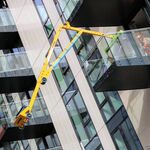1992 February 12 Quebec Transport Minister Sam Elkas announced a
$289M modernization of the line: 58 new cars ($130M contract awarded to Bombardier); electrification to be changed to AC (25,000 volts, 60 Hz); stations to be renovated; tracks and signal system to be rebuilt; a short extension, to Autoroute 640 in Deux-Montagnes, to be added.
[...]
1993, 1994, and 1995, summers Line closed completely for various phases of modernization, as described later. Service was curtailed progressively before shutdown, and restored in stages after work completed. Trains were replaced with various bus services for the duration of the work.
[...]
1994 Fall First deliveries of new cars, built by Bombardier with GE electrical equipment. Cars are stored at a new shop in St. Eustache, north of Autoroute 640, off Boulevard Albert-Mondou, still used today. Test runs were made over a short section of track (25 kV 60 Hz) running south from the shop to a point just north of Oka Road overpass, where DC catenary ended. A short gap in the catenary separated AC and DC systems.
- MU motor car 6731 damaged by fire at Deux-Montagnes; retired, probably scrapped.
[...]
1995 Summer and Fall
- Final phase of renovation work completed, as described later.
- Disposition of DC rolling stock, as described later.
1995 October 26 Line reopened for rush-hour revenue service, after several delays. Rush-hour service was originally to resume August 28, and full-time service September 18.The new trains were an immediate hit with passengers, who were fed up with breakdowns and either roasting or freezing in the old trains. At first, the only apparent problems were with the end doors on some cars not closing properly. Bombardier technicians rode shotgun on some trips, to fix any problems. Full service resumed December 1, after completion of fencing along the line.





